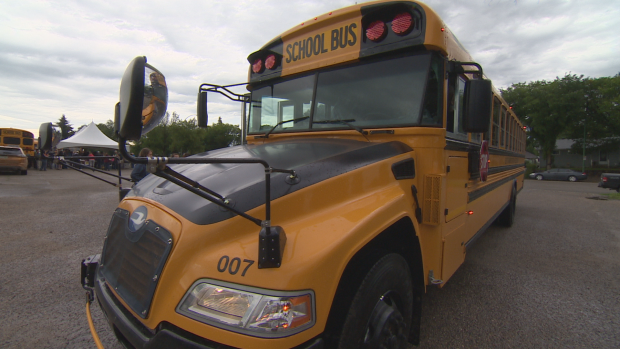Sask. school bus driver wishes every student had to wear a seat belt
A Saskatchewan school bus driver wishes every student had to wear a seat belt on the bus.
Blaize Maygard drives a school bus for Pheasant Rump First Nation. He said there can be up to 20 people on board at a time between the ages of four to 18.
He believes busses would be safer if the children were forced to wear seat belts.
"If the bus driver has to wear a seatbelt, why don't the kids?" Maygard said.
Maygard explained that on his bus only four-year-olds are required to be belted in, which is done by a teacher and parent.
"I don't think they're safe at all if they don't have to wear seat belts," Maygard said.
Report shows seatbelts could help
CBC's The Fifth Estate recently uncovered an internal report by Transport Canada whose author concluded seat belts can prevent occupants from being ejected from buses.
Former bus driver James Park said at first he was concerned about the lack of rules that make seatbelts mandatory. He said he questioned his former employers about that only days on the job.
He explained the reasoning he received was that it would be time consuming for a driver to readjust the seat belt for every child who boarded the bus and they could suffer whiplash if the belt was fastened around their waists.
He says putting the responsibility of making sure kids wear seat belts on bus drivers is not viable.

Former driver calls for monitor on buses
"I'm not going to stand here and say, 'I think seatbelts are a bad idea.' But I still think that unless there was someone else on the bus, another adult on the bus that could monitor the children better, I really don't see a way that the drivers can be expected to monitor the kids and pay attention to the road," Park said.
Park also said the only way for a driver to monitor what children were up to is through a rear view mirror and it's difficult to see what students are doing behind the high-back seats.
"There's no way to know if a kid was taking their seatbelt off and there's no way to police it."
Driver killed in 2010: SGI
Saskatchewan Government Insurance says it relies on the expertise of Transport Canada when it comes to regulating school bus safety, and it won't be conducting a review of its own on the issue of seat belts, according to spokesman Tyler McMurchy.
SGI data shows that in 2017, 92 collisions involving buses happened where six people on board were injured.

"That to me tells me that school buses are a pretty safe place," McMurchy said.
In 2016, SGI recorded 81 collisions involving buses with nine people on board injured.
The provincial insurer noted collisions are recorded when certain criteria are met, like damage exceeding $5,000 and a vehicle is towed from the scene.
SGI says in the past decade, only one person has died in a collision involving a bus and that was a school bus driver.
McMurchy said as it stands, school buses are among the most highly regulated vehicles on the road.
Every school bus in Saskatchewan is inspected at least once a year and twice a year if it travels outside of the province.
"Anybody who's involved in the transportation of children shares the same goal and that's to make sure that those kids get to and from school safely," he said.
"We would expect that if there is credible evidence that would indicate a particular measure may improve the safety of children that Transport Canada would adjust their guidelines accordingly."
School boards, province respond
The Ministry of Education said student safety is paramount and it will continue to watch for developments at the federal level, but did not indicate any plan to review the issue of seatbelts on school buses.
In a statement, Prairie Valley School Division said its buses comply with provincial and federal regulations and will continue to monitor for best practices.
A spokesperson for Regina Catholic School Division also echoed the same sentiments.

